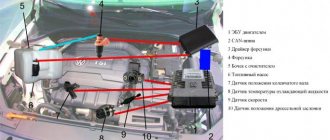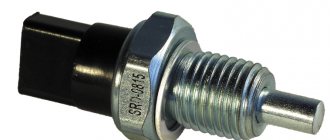Icy rear window
Today, almost all VAZ models are equipped with a heated rear window, since it greatly simplifies driving; in specific conditions, owners of cars without heated glass install it themselves. Most often, of course, heating is needed in bad, rainy and cloudy weather, then the rear window begins to fog up from condensation forming on it, and even in winter, then the glass may become covered with ice. When such conditions occur, as a rule, problems with the heating of the windows begin to arise; we will tell you how to check the heated rear window of a VAZ 2110 and troubleshoot the problem in this article.
Rear window heating diagram for VAZ 2110, 2111 and 2112
1 – mounting block; 2 – ignition switch; 3 – rear window heating switch; 4 – control lamp for turning on the heating; 5 – rear window heating element; K6 – additional relay; K7 – relay for turning on the heated rear window; A – to power supplies
The rear window heating is activated using the auxiliary relay K7 (type 904.3747-10). When the heating is turned on, the orange lamp 4, which is located next to the button, lights up. The heated rear window only works when the ignition is on, since voltage is supplied to the button through an additional relay K6, which is activated when the ignition is turned on. Power is supplied to the heating threads through the contacts of relay K7 from fuse F7, which is directly connected to the power sources.
Checking and repairing the entire rear window heating system
It often happens that replacement or repair of the heated rear window is necessary due to faulty wiring diagrams. Therefore, for repair and replacement we perform the following operations:
- Disconnect the battery terminals
- When you have a stereo system connected to your car that has a security code, make sure you remember (know) the code to enter before disconnecting the terminals
- We pry and remove the heated glass switch from its mounting socket on the dashboard, disconnect the electrical wiring
- It is important to make sure that there is continuity between terminals 1 and 3 of the electrical wiring connector on the relay side
- When there is no conductivity, then the lamp must be replaced
- Using jumper wires, connect “plus” to terminal No. 2, “minus” to terminal No. 4 of the switch contact connector
- Then, using a 3.4 Watt probe light bulb, connect the “plus” to terminal No. 6
- We activate the heater, and the control lamp should shine for 12 - 18 minutes, then go out
- If a faulty switch is detected, it must be replaced
Disconnect the wiring from the switch and check the connector from the harness:
- The continuity between terminal number 4 and ground must be constant
- When the ignition key in the lock is in the LOCK or ACC position, there should be no voltage at terminal number 2 and ground, as well as terminal number 6 and ground
- And in the ON key position, voltage should appear between the described pairs of terminals
- We bridge terminals 4 and 6 from the contact connector and make sure that the rear window heating element is working
- If the switch was faulty, it needs to be replaced
- To identify a relay malfunction, you need to make sure that there is constant continuity of terminals number 1 and number 2
- We apply voltage to them, then make sure that terminal 3 and terminal 5 are open
- Replace a faulty relay
- If the points described above still did not help fix the heating, then it is necessary to replace the glass heating element itself
The check of all glass heating devices has been completed. Additionally, we suggest watching a training video.
Troubleshooting procedure
- We check fuses F8 (20A) and F8 (20A) (mounting block).
- We check the serviceability of the rear window heating button. Is there a “plus” on pin No. 10 of the switch button and after turning on the button on pin No. 9 (a test lamp or multimeter will be useful).
- We check +12V at the Ш5-2 output and at the connector near the rear window.
- We check the wires and their connections.
- We check the rear window heating relay - K7.
- We check the integrity of the glass heating filaments.
The algorithm for determining the cause of a malfunction is similar for most cars, the only differences are in the names of fuses, relays and connectors.
By the way, did you know that to extend the service life of the heating elements, they use a Glass Heating Regulator (DOC), and you can also install a Fresnel lens on the rear window?
Stories from our readers
“Fucking basin. "
Hi all! My name is Mikhail, now I’ll tell you a story about how I managed to exchange my two-wheeler for a 2010 Camry. It all started with the fact that I began to be wildly irritated by the breakdowns of the two-wheeler, it seemed like nothing serious was broken, but damn it, there were so many little things that really started to irritate me. This is where the idea arose that it was time to change the car to a foreign car. The choice fell on the melting Camry of the tenth years.
Yes, I had matured morally, but financially I just couldn’t handle it. I’ll say right away that I am against loans and taking a car, especially not a new one, on credit is unreasonable. My salary is 24k a month, so collecting 600-700 thousand is almost impossible for me. I started looking for different ways to make money on the Internet. You can’t imagine how many scams there are, what I haven’t tried: sports betting, network marketing, and even the volcano casino, where I successfully lost about 10 thousand ((The only direction in which it seemed to me that I could make money was currency trading on the stock exchange, they call it Forex. But when I started delving into it, I realized that it was very difficult for me. I continued to dig further and came across binary options. The essence is the same as in Forex, but it’s much easier to understand. I started reading forums, studying trading strategies. I tried it on a demo account, then opened a real account. To be honest, I didn’t manage to start earning money right away, until I understood all the mechanics of options, I lost about 3,000 rubles, but as it turned out, it was a precious experience. Now I earn 5-7 thousand rubles a day. I managed to get the car buy after half a year, but in my opinion this is a good result, and it’s not about the car, my life has changed, I naturally quit my job, I have more free time for myself and my family. You’ll laugh, but I work directly on the phone)) If If you want to change your life like me, then here’s what I advise you to do right now: 1. Register on the site 2. Practice on a Demo account (it’s free). 3. As soon as you get something on the Demo account, top up your REAL ACCOUNT and go to REAL MONEY! I also advise you to download the application to your phone, it’s much more convenient to work from your phone. Download here.
I was faced with the heated rear window of my car not working, the problem was...
Source
Reasons why the heating does not work on the rear window of the VAZ 2110
Almost all VAZ 2110 cars have a rear window heating system. But even if this system is not provided for in some models, it is usually “finished”, since here we are talking about basic comfort today. If the rear window heating does not work on a VAZ 2110, this creates many problems.
As a rule, heating is especially needed in cloudy, cold weather in autumn and early spring, when the glass becomes covered with condensation, blocking the driver’s visibility of what is behind the car.
Rear window with heating filaments
This lack of vision is especially dangerous when parking. The same can be said about winter use, when the frost literally draws patterns that you don’t want to admire at all.
Why do the heating, heater and wipers fail at the same time?
Separately, situations stand out when the stove, wipers, and heated rear window do not work. Sometimes, along with these systems, the washer also stops working.
A one-time failure of these devices causes a lot of problems; problems can occur periodically, but they affect the safety of the car. The peculiarity of this breakdown is that the operation of all components is tied to one fuse.
Ways to eliminate the defect:
- To quickly solve the problem, just replace the fuse;
- When examining a faulty unit, it is easy to notice burnt tracks, which can also be soldered.
How the system works
The operating principle of heating is very simple; it is used today in almost all cars, including foreign cars. Something simpler and better has not yet been invented. A conductive thread is applied to the rear window on the interior side, which heats up; accordingly, the glass is heated, which eliminates fogging from the inside, as well as snow and ice located on the outside.
Rear window heating operation diagram
This system is made up on a VAZ 2110:
- the thread itself, which provides heating;
- wiring going to it;
- heating relay;
- switch with signal light inside;
- fuse.
That is, nothing complicated for a craftsman. Considering that the size of the rear window of the VAZ 2110 is 121.3x67.6 cm, the heating size is usually only a couple of centimeters smaller, and essentially covers the entire surface, providing complete heating and good visibility of what is happening behind. There is no point in installing a much smaller heating system, because the driver should see the entire road behind, and not part of it.
Heating system design
The principle of operation of heating the rear window of a car is the same for all cars, since it is simple and practically does not differ on different models, both domestic and foreign. A thin metal conductive thread is applied to the inner surface of the glass, which, when heated, allows snow and ice to be removed from the outside. And from the inside it prevents fogging, improving the driver’s visibility.
On this family of VAZ-2110 vehicles, the heating system may differ only in size (number of threads) depending on the dimensions and configuration of the rear window. It consists of the following components:
- a conductor that provides heating for the system;
- relay controlling heating;
- wiring for system operation;
- switch with signal lamp;
- fuse.
Taking into account the dimensions of the glass surface (for the VAZ-2110 they are 121.3 by 67.6 cm), the heating conductors have a laying area of 2-3 cm less on each side of its surface.
This is enough to fully warm up and ensure good visibility of the road situation behind the car through the mirrors. Car service specialists warn motorists against installing smaller systems, since the difference in price will be insignificant, but viewing the road will be significantly reduced.
Causes of malfunctions and their identification
The heated rear window works as soon as the ignition is turned on, and the glass should clear within a couple of minutes. But sometimes it happens like this:
- The power-on signal does not light up, although the button is pressed, the glass does not defrost (remains foggy);
- The heating does not work, but the control light is on;
- The glass thaws in stripes;
- Heating is insufficient. This phenomenon occurs if the glass is heavily frozen. In this case, simply clear it of ice mechanically.
Rear window defogger time relay
The root cause of other phenomena should be sought:
- in relay control;
- check the condition of the fuse in the box;
- Check to see if the connectors on both sides of the rear window are secure. They may need to be cleaned;
- also check for breaks in the supply wires in the switch itself;
- if everything is in order here, you should check the conductive thread. With the engine running, you need to check the voltage approximately in the middle of each section (strip) of the thread. If the meter shows about 6 volts, everything is fine. If the readings are about ten, or, conversely, about zero, it means there is a break. A technique will help to determine exactly where the break is: the device has a pointed electrode, wrapped in a wide foil strip, and is led along a “suspicious” conductive strip. Where there is a voltage surge, there is a break;
- but often you can literally see the break - the thread has come apart in some area.
Device
First, let's get acquainted with the structure of this system.
It includes the following elements:
- The thread that provides heating.
- Wiring (positive and negative).
- System switch. Equipped with a warning light inside.
- Heating relay.
- Fuse.
- Control buttons.
This system works very simply. There is a conductive thread on the rear window. It warms up when power is applied. This way the glass is heated and condensation is removed from the inside.
Why does the rear window heating not work on a VAZ-2110 car? The reasons may be trivial. After all, the device has no mechanical parts. Therefore, all you need for diagnostics is a multimeter and a test lamp. This is the only way to find out why the heated rear window of the VAZ-2110 does not work. There is a photo of the diagram in our article.
Below we will look at the main elements to check.
Operating principle of heating
The principle of operation of the heater is very simple - a conductive thread of strictly defined resistance is applied to the rear window, it heats up from the current passing through it. In this case, the supply voltage is provided by such components as wiring, a heater relay, a power button and a fuse (see VAZ 2110: how to replace fuses) A similar scheme is used on all VAZ cars (and on the vast majority of foreign cars), starting with the “classics” and ends with the latest models.
The heated rear window of the VAZ 2110 does not work, what is the reason?
Almost all VAZ 2110 cars have a rear window heating system. But even if this system is not provided for in some models, it is usually “finished”, since here we are talking about basic comfort today. If the rear window heating does not work on a VAZ 2110, this creates many problems.
As a rule, heating is especially needed in cloudy, cold weather in autumn and early spring, when the glass becomes covered with condensation, blocking the driver’s visibility of what is behind the car.
Rear window with heating filaments
This lack of vision is especially dangerous when parking. The same can be said about winter use, when the frost literally draws patterns that you don’t want to admire at all.
How the system works
The operating principle of heating is very simple; it is used today in almost all cars, including foreign cars. Something simpler and better has not yet been invented. A conductive thread is applied to the rear window on the interior side, which heats up; accordingly, the glass is heated, which eliminates fogging from the inside, as well as snow and ice located on the outside.
Rear window heating operation diagram
This system is made up on a VAZ 2110:
- the thread itself, which provides heating;
- wiring going to it;
- heating relay;
- switch with signal light inside;
- fuse.
Diagram of elements of the glass heating system
A detailed diagram of the heated rear window system of the VAZ 2110 is shown in the figure below, according to it:
- The glass heating element is activated using an auxiliary relay designated K7 of type 904.3747-10, which is installed in the mounting block
- When the heated rear window is turned on, control light 4, located next to the switch, immediately lights up, it illuminates the switch key in red or orange.
- In VAZ 2110 cars, the heated rear window can only be turned on if the ignition is turned on, because the voltage to switch 3 goes through another relay designated K6, which is activated when the ignition is turned on.
- The power supply to the glass heater is supplied from relay contacts K7 through fuse F7, connected directly to the power source
- If you turn on the heating, but the rear window is not heated, then you need to check the condition of fuse F8, as well as the wires connecting them, and also relay K7 and switch
Complete heating connection diagram
Checking and replacing the heating relay
Typical VAZ glass heating relay
Problems that arise over time with heating the rear window are often associated with circuit problems, a blown fuse, as well as a heating relay:
- In VAZ model cars, the rear window heating relay is used to turn on the heating for a certain time within fifteen minutes
- This system operates thanks to a built-in timer.
- For vehicles in which a relay was installed, such a system can be located in the standard relay block or in the fuse box
- And in place of the standard relay, a new one is simply inserted and the heating is turned on with a standard button
- It is very important here that the winding of this relay is constantly connected to ground.
- The purpose of the relay is to turn off the heating when the motor is not running. The most important thing is that heating does not drain the battery
Relay replacement
If the glass heating does not work due to a broken relay, then the instructions dictate the following actions:
- First you need to disconnect the battery from ground
- Then remove the heating switch from the dashboard and disconnect its connector
- Next, you should check the condition of the circuit between the ends (terminals) of the 1st and 3rd connectors located on the relay side
- Be sure to check the status of the heater timer
- The control (test) light of the switch lights up when turned on and goes out after 12 minutes
- When the switch does not function, then it needs to be replaced
- Then the condition of the circuit from the side going to the switch connector is checked
- When the ignition key is in the off position, there will be no voltage
- We connect pins 4 and 6
- Then we check the operation of the heater
- If something does not work, then you will have to replace the switch
- The heating relay should be located in the fuse box, which is located in the passenger compartment
- It turns on only when you turn the ignition key in the lock and continues to work when the engine is running
- We turn on the heating by pressing the power button, after twenty minutes of operation the heating automatically turns off
- This heating function is very convenient and even necessary.
- You can install the relay in the rear window heating system yourself, or at a service station if you are satisfied with their price
Fuse
If your rear window heating does not work, your VAZ-2110 should be checked for a blown fuse. In the mounting block, check the elements in connector F8 (usually they are rated at 20 amperes). If the fuse looks like the one in the photo below, it needs to be replaced.
For the future, experienced car owners advise carrying a spare set in the glove compartment. After all, if the fuse for the fuel pump burns out (especially while on the road), then the car will not be able to start at all.
What is the reason for this phenomenon? Most often this happens due to a short circuit. At one point, the voltage on the on-board network increased above normal. To prevent the contacts from melting, the system is simply turned off by breaking the connecting elements. In this case, this is +12 V power and conductive elements on the rear window.
Eliminating the break
Patching a cliff in general is not a difficult task, and there are several ways to solve it. The most commonly used is electrically conductive paste. Before repairing, it will be necessary to secure the broken area with adhesive tape (two pieces - one for each fragment of the track). The ends of the thread are cleaned and washed with alcohol. The paste is then applied to them and left to dry for at least 24 hours.
You can also restore the functionality of the rear window heating element using:
- glue (type BF);
- metal filings;
- magnet
Sawdust is quite easy to make using a file yourself. In turn, any magnet will do. It should be placed on the outside of the window, and metal dust should be placed on the inside, where the heating element is located. Then the joint remains to be treated with glue and varnish. Any oil paint can also be used.
Heating can be repaired quite effectively with a soldering iron. Here you will need solder containing a small amount of tin (for example, POS-18); in this case, instead of flux, use zinc chloride. But this method is suitable only if the cliff is small. You will have to fill a large area with either copper or silver wire.
In addition, it should be noted that now in stores there are also special adhesive compositions for repairing heating filaments. But for some reason they are currently not in demand.
The video below will help you understand in more detail how to repair a damaged rear window heater:
Troubleshooting and Troubleshooting
Common manifestations of heating malfunctions, which should start working simultaneously with the ignition being turned on, may include the following symptoms:
- If there is a light signal for the system operation, the glass is not heated.
- The same thing happens when the button is pressed, but without a light signal.
- Not all glass thaws (this usually shows up as strips of thawed and frozen water).
- The surface does not thaw completely - due to severe freezing or attempts to mechanically remove ice.
The search for the causes of the malfunction should begin by replacing the corresponding fuse, which is responsible for the operation of this device in the VAZ-2110. In our case, this is a fuse marked F8 in the corresponding block, which protects the heated rear window. This block is located to the left and slightly lower from the steering wheel. For correct diagnosis, the fuse, even if it looks intact, needs to be replaced with a new one and the heating operation checked.
If the previous manipulation did not bring results, you need to check the car wiring from the rear window heating button. Burnt wires or breaks along their route will clearly indicate the cause of the malfunction. It is worth noting that a completely non-functional system is quite rare - much more often only some part of it fails. In this case, all heater filaments are usually checked for breaks, since it is obvious that they do not heat up due to the fact that current has stopped passing through them.
The most common cause of this phenomenon is mechanical damage to the conductors. Despite a fully functional system that will help melt the ice on the rear window of a car in a short time, many impatient drivers are in a hurry to free this surface from the “ice captivity” outside or from fogging from the inside using various improvised means, while harming the performance of the profile device due to vibration or physical contact.
If the system does not work correctly, the car owner checks which heating threads have stopped working. To do this, you just need to turn on the device and visually observe in which areas the glass does not heat up. Next, those places where the system does not work are carefully cleaned and inspected with a magnifying glass - this is how the place where the conductor breaks is located. In this case, it makes sense to check all conductive threads. Firstly, a break even on one strip can occur more than once, and secondly, you can accidentally discover places of future breaks, which can be expressed in the form of burrs, sagging, tears and scratches.
After identifying all emergency and unreliable places, it is necessary to treat them with a special paste (lubricant, spray), which, when dried, forms a conductive substance and completely restores the functionality of the rear window heating system.
Troubleshooting in the OZS system
If you find signs that the rear window heating is not working, you must carefully check the entire electrical circuit of the vehicle's EOS system.
The first thing to check is the serviceability of the fuses. So, for example, on a VAZ-2110 these are rear window heating fuses F4 and F7, which are located in the mounting block. Their malfunction may occur due to a factory defect, short circuit or voltage surge in the on-board network. The faulty fuse needs to be replaced, for which it must be removed from the mounting block.
Next, you need to check the terminal connections in the OZS system. When operating a vehicle, all equipment is subject to strong vibrations. As a result, the contacts may be damaged or a terminal may become disconnected or loose.
The heated rear window relay must also be checked. Breakdown of the relay is possible when the wire in the working coil of this part breaks or due to burnt contacts, due to a manufacturing defect or short circuit. To check it, the relay must be removed and checked using a tester. If this part malfunctions, it needs to be replaced with a working spare part.
You should also check the rear window heating contact. A conductive element is attached to the rear window using glue, which is a contact to which an electric current is supplied through a wire, which is transmitted through this contact to the heating filaments.
In this place, the wiring may break or, due to the fact that the glue was of poor quality, the contact element may peel off from the glass.
Quite often, the failure of the rear window heating is caused by a break or damage to the threads in the heating element on the rear window. This is detected by visual inspection or instrumental analysis. Visually, only obvious damage to the thread can be detected by identifying a gap between the damaged ends.
It is possible that during some repair work on the car, mechanical damage was caused to the surface of the glass on which the heating element is attached using glue.
However, the main tool for diagnosing this malfunction is a voltmeter or ohmmeter.
Damage to the heating filament
For what other reasons does the rear window heating not work? VAZ-2110 is equipped with special threads. A break can happen here too. The threads are a small layer of conductive substance.
It is easily damaged by the slightest mechanical impact (even with such harmless actions as removing tint). You can determine the location of the damage using a magnifying glass. It is advisable to carry out diagnostics during daylight hours. Damage to the threads is one of the obvious reasons why the rear window heating partially does not work on the VAZ-2110.
What causes interior glass to sweat?
Why do the windows on a VAZ 2110 fog up? This is a question that baffles half of car owners. I’ll say right away that this most likely happens in cold weather due to increased humidity in the car interior, from which I’ll now explain:
- The most common reason is if the driver has a hangover, the windows sweat from fumes
- The second most common reason is that the interior heating radiator is leaking quietly, the liquid collects under the rugs, while the leak is small, it is almost unnoticeable, so it is worth checking the condition of this radiator
- Another reason for glass fogging may be the wrong direction of the stream of warm air from the stove; if the glass is blown, it dries, when it is not blown, it may begin to “sweat”, this, by the way, is the main reason why the windshield on a VAZ 2110 sweats
How to repair the conductive layer? Method No. 1
You can do this yourself. To do this, you do not need to dismantle the glass. All you need is to purchase a special conductive paste (available in auto stores or on the market) and apply it to the damaged area. It is important to prepare it carefully. To do this, carefully clean the varnish from the surface and degrease the area with alcohol (use a piece of soft rag). Next, we clean the ends of the damaged threads. We apply adhesive tape or electrical tape to its upper and lower parts so that there is a small gap (no wider than the thread itself). We apply a special adhesive into it. After a day, the composition will completely dry out. Next, you can remove the remaining tape and check the system for functionality. If the heating works only partially, it means that the break occurred in several places. Find the second place where the thread is damaged and treat it with a conductive compound using a similar principle. That's all. We will also consider the old-fashioned method of repairing threads.
The procedure for repairing a faulty OZS system
Having determined the reason why the rear window heating does not work, you can begin to repair this system.
- If the fuses or relays of the OSZ system are faulty, then the faulty parts must be removed. Replacing them with new, functional ones is not difficult. The main thing is that they are installed as indicated by the on-board electrical system diagram.
- In the case where the culprit of the damage in the OZS system is the terminal connection, restoring the heated rear window is also not difficult. It is enough to clean the contacts in the terminals. The terminal box may need to be replaced, but this will not take much time either.
- If the glue that was used to attach the contact on the rear window turned out to be of poor quality and peeling occurred, then in this case you need to buy a new high-quality conductive glue. Remove the layer of old glue from the peeled contact using a napkin with an alcohol solution. Then apply a layer of new connector and glue the contact in place.
- If a wire is torn off on one of the buses, it is necessary to solder this wire to the old place using the connection diagram. The procedure is as follows:
- remove the remnants of old solder from the wire, stripping the end; in addition, you need to clean the connection point on the bus;
- Using a brush, apply rosin paste as a flux to the cleaned surfaces of the bus and wire;
- Apply solder containing three percent silver to the cleaned and rosin-coated wire core;
- solder the wire to the bus, while avoiding overheating of the surfaces.
- The greatest care when repairing the heated rear window with your own hands is required if a break is detected in the conductive threads of the heating element of the OZS. To make this work easier, special repair kits for this system are available. To correct the damage, perform the following steps:
- in the area of the rupture, clean an area six millimeters long in each direction from the damage site;
- wipe the cleaned area with a napkin or cloth soaked in alcohol or an alcohol solution;
- On both sides of the damaged thread, stick thin strips of repair adhesive tape or ordinary construction tape, if there is no repair kit. Avoid sticking adhesive tape onto nearby threads to avoid damaging them;
- if you have a repair kit, mix the hardener with a silver-colored composition, which, after application, will act as a conductive thread. After mixing, apply this composition with a stick or brush to the damaged area, closing the circuit.
- if there is no repair kit, then the role of a special mixture will be played by glue, which conducts electricity well; it can be applied with a brush, being careful;
- after repairing the damage, you need to give time for the glue or special mixture to harden; you can use a hairdryer to speed up this process;
- after the conductive strip has dried, you must carefully remove the self-adhesive tape; to do this, it is best to cut it with a knife at the junction of the thread being repaired, so as not to damage it when removing the tape;
- After the work has been completed, you need to check the functionality of the OZS by starting the car engine and pressing the OZS power button.
See also video on the topic:
| Heated rear window is useful not only in winter, when you can’t see anything on the glass due to ice and snow, but also in summer, when it rains and the glass fogs up. The malfunction of this option causes a number of inconveniences and makes the train less safe, because visibility is significantly reduced. Let's look at the reasons why the heated rear window of a car does not work. |
Method number 2
This method involves the use of non-ferrous metal shavings as a conductive element. Also, to repair the thread, we will need a transparent varnish (it is advisable to use a thick one, like for nails).
Mix the shavings with a brush and apply to a strip previously sealed with tape, as in the previous case. After an hour, the varnish will completely dry. The method is quite old. It is not always possible to connect damaged contacts as needed. Therefore, if it is possible to buy conductive glue, it is better to use the first method. It will be much faster, easier and more reliable. The cost of a 10-gram tube with this composition is 78 rubles. This volume is more than enough to repair several damaged heating threads.
Source











